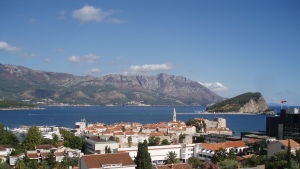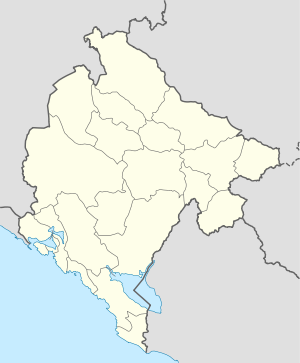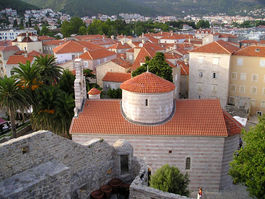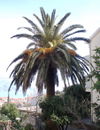Budva
| Budva Будва |
|||
|---|---|---|---|
 |
|||
|
|||
 Budva
|
|||
| Coordinates: | |||
| Country | |||
| Settlements | 33 | ||
| Government | |||
| - Mayor | Rajko Kuljača (DPS) (DPS - SDP) | ||
| Area | |||
| - Total | 122 km2 (47.1 sq mi) | ||
| Population (2003 census) | |||
| - Total | 10,918 | ||
| - Density | 130/km2 (336.7/sq mi) | ||
| - Municipality | 15,909 | ||
| Time zone | CET (UTC+1) | ||
| - Summer (DST) | CEST (UTC+2) | ||
| Postal code | 86000 | ||
| Area code | +382 33 | ||
| ISO 3166-2 code | ME-05 | ||
| Car plates | BD | ||
| Website | http://www.opstinabudva.com/ | ||
Budva (Montenegrin[1]: Будва, Budva; Italian: Budua, Greek: Βοδοα, Vodoa) is a coastal town in Montenegro. It has around 15,000 inhabitants, and is a centre of Budva municipality. The coastal area around Budva, called the Budvanska rivijera, is the centre of Montenegro's tourism, and is well known for its sandy beaches, diverse nightlife, and beautiful examples of Mediterranean architecture.
Budva is 2,500 years old, which makes it one of the oldest settlements on the Adriatic sea coast.
Contents |
History
There is vast archaeological evidence that places Budva among the oldest urban settlements of the Adriatic coast. Substantial documentary evidence provides historical references dating back to the 5th century BC.

A legend recounts that Budva was founded by Cadmus the Phoenician, a hero exiled out of Thebes, Greece, finding a shelter in this place for himself and his wife Harmonia. Two other civilizations also left innumerable traces: the Greek and the Roman. Upon the fall of the Roman empire and its division into east and west, the defensive barrier which separated the two powers happened to run across this area, subsequently making a lasting impact on the history and culture of this town. In the Middle Ages, Budva was reigned by a succession of Doclean kings, Serbian and Zetan aristocrats.

The Venetians ruled the town for nearly 400 years, from 1420 to 1797. Budva, called Budua in those centuries, was part of the Venetian Republic region of The Bay of Kotor (Boka Kotorska) and was fortified by powerful Venetian walls against Ottoman conquests. According to the historian Luigi Paulucci in his book "Le Bocche di Cattaro nel 1810" (The Bay of Kotor in 1810), most of the population spoke the venetian language until the beginning of the nineteenth century,
In the very turbulent years that followed, Budva saw a change of several of its supreme rulers – Austria, France and Russia. A union of Boka Kotorska (and Budva) with Montenegro took place for a brief period (1813–1814), but from 1814 until 1918 Budva remained under Austrian Empire. After WWI, in 1918 Serbian army entered Budva abandoned by Austrian forces and it came under the Kingdom of Yugoslavia and was later annexed to the Kingdom of Italy in 1941.

During World War II many people of this area died in the fight against fascist invaders. Budva was finally liberated from Nazi rule on 22 November 1944 and, after belonging once again to Yugoslavia, is now part of the newly independent Montenegro.
A catastrophic earthquake struck Budva on 15 April 1979. Much of old town was devastated, but today there is little evidence of the catastrophe – almost all the buildings were restored to their original form.
Population
Budva is the administrative centre of Budva municipality, which includes the neighbouring towns of Bečići and Petrovac, and has a population of 16,095 (2003 census)[2]. The town itself has 14,458.
.jpg)
2003 population Census[2] - 16,095 citizens:
- 7,333 Montenegrins (45.56%)
- 6,510 Serbs (40.45%)
- 460 Others (2.86%)
- 205 Muslims (1.27%)
- 177 Croats (1.10%)
Old Town

The Old Town in Budva has many different tales and stories of its origin. Scholars and Historians believe it to be originally an island, which later joined the shore to form a sand isthmus. The Old Town, along with the city of Budva was said to have been discovered by a Greek sailor by the name of Boutoua. Eventually the Roman Empire took over the whole Montenegrin coast influencing it greatly.

Much of the architecture in the Old Town is of Venetian origin. Doors, hinges, windows, balconies and many other small but noticeable things seem to hold the Roman style of the Republic of Venice. There are also three main churches in the old town. The first is St. Ivan's which was built in the 7th century AD, second St. Mary's of Punta dating from 840 and the third, The Holy Trinity, which was built in 1804. The venetian walls of the Old town are a famous tourist attraction.
.jpg)
The Old Town is also famous for the earthquakes it suffered in 1979, where the whole town had to be rebuilt; it took 8 years (until 1987) for it to be completely finished.
Tourism
Budva is the capital of Montenegrin tourism. With over 330,000 guests in the 2007 summer season, it is by far the most popular tourist destination in Montenegro.
Because of its 11,310 m (37,106.30 ft) of sandy beaches in and around Budva, and its vast cultural heritage, beautiful architecture, and vibrant nightlife, Budva is increasingly attracting foreign tourists. This makes it the most attractive tourist destination in Montenegro.

Due to its nightlife, Budva is popular among young people. They move in crowds from open-air clubs that are lined along the main promenade, and then to closed nightclubs around 01:00am, which are usually crowded until morning. Budva also boasts some of the highest prices of drinks and food in the region.
Budva's most famous beach is Mogren. Nestled in-between several large cliffs it is accessed by a 500 m (1,640.42 ft) pathway from Budva's Old town. Other beaches within official city limits include Ričardova glava (Richard's Head), Pizana, Slovenska (Slovenian Beach). Many other beaches are located just outside of Budva in smaller adjacent towns and villages such as Bečići, Jaz, Trsteno, Maestral, Miločer, Sveti Stefan, Pržno, Kamenovo, Ploče, Crvena Glavica, Drobni Pijesak, Kraljičina plaža, Kraljrva plaža.
Outside the old town, Budva does not offer many historical sights. Instead, much of the city consists of new age Mediterranean-style buildings, or private lowrise dwellings. During the turbulent 1990s, Budva grew and expanded without any form of urban planning, which resulted in parts of town featuring narrow streets and numerous cul-de-sacs. This is the reason of major traffic jams during the summer season.
In the near vicinity of the town of Budva there are exclusive resorts such as town-hotel Sveti Stefan and Miločer, places frequented by various celebrities as well as local businessmen and politicians.

There are a few notable drawbacks in development of tourism in Budva. The biggest is inadequate infrastructure of the town. The most quoted problem in Budva, as in all of Montenegrin coast, is shortage of tap water. Scarse watersheds around Budva became completely inadequate for growing town in the early 2000s, so taps in Budva become dry during daytime for most of the summer months. Recently, as number of tourists at peak times reach 100,000 in Budva, electricity shortages also became a commonplace.
The other serious problem is traffic and parking in and around Budva. As most of the beaches are located around Budva, tourists returning from beaches in the afternoon usually jam the roads along the coast, so the trip from Sveti Stefan to Budva, some 10 km (6.2 mi), takes around an hour.
Car parking is also a major problem. Increasing number of tourists are coming to Budva with their own car, so there is overwhelming demand for parking space around the town center. Sometimes one has to wait in line to get a space on a parking lot up to an hour.
Hotels are usually spared these problems, as they have privileges when it comes to water and electricity supply.
Transport
Budva is connected to inland Montenegro by two-laned highways. There are two ways to reach Budva from Podgorica - either through Cetinje, or through the Sozina tunnel (opened 2005). Either way, Podgorica, the capital and main road junction in Montenegro, is around 60 km (37 mi) away.
Budva is connected to the rest of coastal towns of Montenegro by the Adriatic Highway, which extends from Ulcinj in the far south to Herceg Novi, and on to the Croatia.
Tivat Airport is 20 km (12 mi) away. There are regular flights to Belgrade and Zurich, and dozens of charter planes land daily on Tivat airport during the summer season.
Podgorica Airport is 65 km (40 mi) away, and it has regular flights to Belgrade and other European destinations throughout the year.
Climate

Budva has a typical Mediterranean climate, with warm summers and mild winters, and 230 sunny days in a year. Budva comes among the warmest Mediterranean towns with an average temperature of 8 °C (46 °F) in January and 29 °C (84.2 °F) in July. The average summertime temperature is 25 °C (77.0 °F) and 9.3 °C (48.7 °F) in the winter. The temperature of the sea reaches up to 24.7 °C (76.5 °F) in the summer months, while it keeps between 18 °C (64 °F) and 19 °C (66 °F) in the autumn.
Trivia
- Locally, Budva is referred to as the Montenegrin Kuwait, because of its immense number of millionaires, compared to its small population. Following a real estate boom in 2000s, many native families sold their properties in and around Budva to foreign buyers, mostly Russians, Irish, and Britons. Once barren and undeveloped fields of steep hillsides are being sold for hundreds euros per square meter. This resulted in a once poor fisherman's village to become a town with the most millionaires per capita in Europe [1], about 500 for the population of around 22 000 in whole municipality. Many of the newly rich re-invested their money in real-estate, buying flats in central Podgorica and Belgrade, which further raised the prices of living space in Podgorica.
- Budva has the distinction of being the smallest town to host a concert of The Rolling Stones. The group held a concert on 9 July 2007, at Jaz Beach, as a part of their A Bigger Bang Tour. The show saw an attendance of some 35,000 spectators, twice the population of Budva town itself.
- Madonna staged a show at the same venue on 25 September 2008, while Lenny Kravitz and Armand Van Helden performed at Jaz beach during the "Live Fest" in August 2008, along with Goran Bregović, Dino Merlin and Zdravko Čolić.
- Budva was host of Class 1 Powerboat Grand prix in May 2008. It will take place in this city for the next 4 years.
- Budva, together with nearby Kotor, was host to the Federation of European Carnival Cities (FECC) World Carnival City Congress in May 2009.
International relations
Twin towns - Sister cities
Budva is twinned with:
Notes
- ↑ Constitution of Montenegro
- ↑ 2.0 2.1 Djordje Capin. "Boka Kotorska Census 2003". Rastko.users.cg.yu. http://rastko.users.cg.yu/boka_kotorska_census_2003.htm. Retrieved 2009-05-05.
- ↑ "Banská Bystrica Sister Cities". © 2001-2008. http://eng.banskabystrica.sk/main.php?id_kat_for_menu=2367&firmy_slovenska_flag=0. Retrieved 2008-12-14.
Official sites
Photos
References
External links
- Official web site
- Official web site of Tourism Organization of Budva
- Radio Budva
- Bus Schedule in Budva (1944 x 2592, JPG, 745 Kb)
See also
- List of ancient cities in Illyria
|
|||||||

